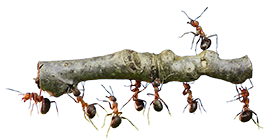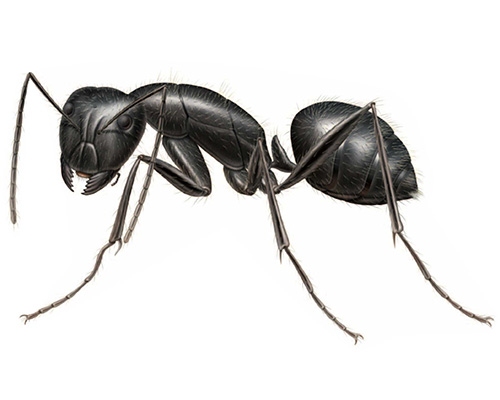
Eugene Carpenter Ant Control
While there are, many varieties of Carpenter Ants (Camponotus pennsylvanicus) and (Camponotus vicinus) are the two most common ones found in the Eugene and surrounding areas. One is the Modoc and is all black in color. The other is Vicinus and it has both red and black body parts in various configurations. Both are very distinct, yet they are very compatible. It is quite common to find both species in the same colony.
You might ask why these ants are called Carpenter Ants. The name describes one of the peculiar habits they perform. As they tunnel through wood with precision, their work reveals a finely finished and smooth tunnel and gallery. It looks almost as though they used sandpaper to make them so smooth. Finely finished wood, just like a human journeyman carpenter would do, thus because of the finely finished galleries, they are commonly called Carpenter Ants.
Once you determine you have ants, how to do you know if they are carpenter ants. Actually, it is easy to see the difference. The Carpenter Ant is among the largest of all ants in the Pacific Northwest and can range in size from 12 inch to over 1 inch. They are several times larger than a sugar ant. These ants are huge!
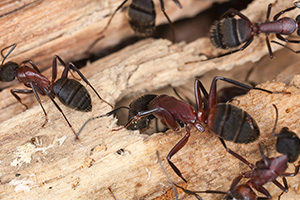
Damage
Make no mistake; Carpenter Ants will do a significant amount of damage to a structure over time if left untreated. Do not underestimate these ants, as they are a serious threat to the stability and soundness of an infested structure. Over a long period of time, the cost of repairing the damage can be almost overwhelming. However, in most cases, little or no structural repair is necessary if the problem is dealt with early in the infestation. However, left untreated it could turn into a costly and time-consuming repair.
Eugene Carpenter Ant Control | Merles Eugene Pest Control
What is that noise I hear in the walls? It sounds similar to the rustling of paper when you crush it in your hand. If it is a mouse, when you tap the wall it will stop. If it is Carpenter Ants, the noise will continue uninterrupted. The sound is from the ants clicking their mandibles together; actually, it is a form of communication between them. When you have many ants, hundreds of them in the wall it sounds like a jam session going on, lots of noise.
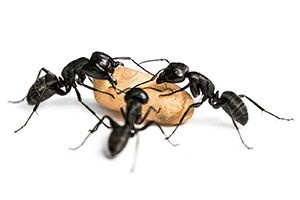
Diet
Carpenter ants are scavengers and will eat, among other things, dead insects or substances high in protein andcarbohydrates. Since protein is their main source of food, they are not interested in sweets, so your morning donuts are safe.
Their dietary needs will also include some basic foods such as “honeydew” that they get from aphids. They will protect aphids from other predatory insects almost as a farmer protects his cows from wolves. These ants will actually milk the aphids for the honeydew in ways that are similar to a farmer milking their cows. Another source of food comes from the nectarproduced by plants.
Even though you may see them in large numbers during the day, Carpenter Ants are nocturnal and most active from about 10 PM to 3AM. This is when they are most likely to be foraging for food from dead insects, and sometimes even from live ones.
The worker Carpenter Ant will ingest its food in a liquid form, then return to the nest, and feed the queen and the larvae by regurgitating the food. Since they ingest the food, liquid baits do not work well on this species of ant. Poison baits work rather quickly resulting in killing one ant at a time. This is not a very effective means of control. By comparison, sugar ants do not ingest their food but rather carry it back to feed the larvae and queen destroying the colony. With Sugar Ants, liquid baits are a very effective tool but is almost useless in the control of Carpenter Ants.
Carpenter Ants do not eat wood because they are not able to digest cellulose. They make tunnels through the wood using their mandibles and the excessive wood is removed and discarded. This is why you may find piles of sawdust near active areas of ant infestations. When they begin to tunnel through wood they usually prefer damp or slightly rotted wood to make their nest in. As the colony grows, the worker ants will start tunneling from the damaged wood and will continue making galleries and tunnels even in sound and undamaged wood.
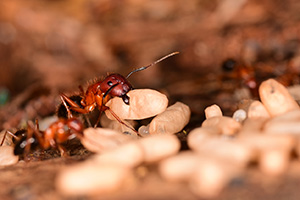
Nesting
Carpenter ants prefer to nest in structural lumber such as in wall voids, hollow doors, windows and foam panels. They typically seek wood that is softened by moisture, decay or damaged by other insects. In addition, they can and often do gain access through cracks or crevices around doors, windows, holes in the siding, or through plumbing, electrical and utility wiring holes. Even decorative bark, dirt or ground coverings up against the siding and covering the foundation can give these ants access to your home. They can and do use shrubs, bushes or trees that have contact with the structure to gain access. This is why all bushes, shrubs, and trees must be trimmed away from touching the structure.
They will build their nests not only in wooden structures such as houses and detached garages but also in old tree stumps, unused piles of firewood, and sometimes even in live trees. From these nests, they will begin to establish satellite nests, even as far away as 14 of a mile. Therefore, an infested house may not necessarily contain the primary nest, and in most cases, they do not. So make a careful survey of all the property to discover any other nests.
Eugene Carpenter Ant Control
Finding multiple Carpenter Ants inside your home is a sure sign you have a problem. Especially if you find piles of sawdust or wood like shavings in windowsills, ceiling areas, under cabinets, under doors or around door jams. These are indicators of a severe ant infestation. Seeing flying winged ants inside your home is another indicator of a problem. These flying ants are the reproductive stage of the ant. A mature nest will produce about 400 of these flying ants per season and generally appear in the fall. The queen Carpenter Ant can live more than 40 years.
You have Carpenter Ants and the problem is bad. Now what? To treat effectively you need to find the primary nests along with the satellite. While there are many pest problems you can effectively deal with yourself this is not one of them. It takes a great deal of skill and knowledge to form an effective plan of treatment. The right materials must be used in the right places at the right time. Poor placement of materials for their control can result in the ants being flushed into other areas of your home. Carpenter Ants are experts at survival. They will even place materials over chemically treated areas to gain safe passage. They have been known to send ants across one specific area of treatment until a safe path has been made. They may lose 1/3 of the nest doing so, but the colony will survive. Simply placing material, a little here, a little there will not work. They will simply go into hiding until they emerge stronger, safer and in greater numbers. Do not underestimate them, they have a more cunning and intense sense of survival than you may realize.
For additional information on Eugene carpenter ants
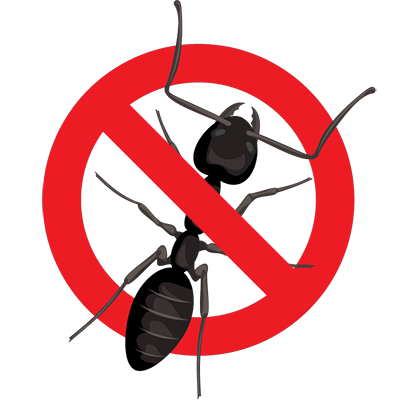
I know how Carpenter Ants work, I understand their survival skills, I know where they nest and hide. I have been thoroughly trained to find them, to contain them, to destroy them. I will do so using materials that are safe around you, your family, and your pets. I am Thaddeus Pacewicz, and I am here to help you take control of your home and environment from Carpenter Ants. I will be relentless in solving this problem until it is done. This I promise, I will settle for nothing less.
Eugene Carpenter Ant Control
Call today ((541) 514-3027) for fast results you will see tomorrow.
Pest Navigator:
If you have seen any of these lately call me, Thad, and I will help you safely regain control over your home environment.

